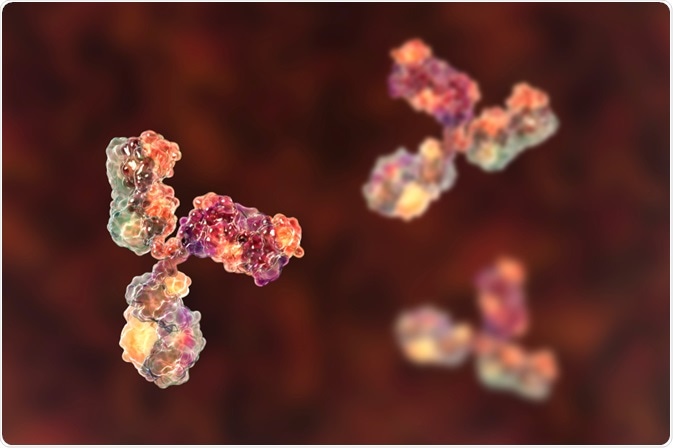Antibodies are highly selective agents that can be used to target a variety of cancers and pathogenic infections in humans. Antibody production is usually carried out using mammalian cell culture. However, during production, these cells produce proteases that degrade the antibodies, thus necessitating the use of protease inhibitors.
Scientists from the National Institute's of Health have demonstrated a method to quantify a common protease inhibitor, termed AEBSF, by reversed-phase liquid chromatography coupled to UV detection (RPLC-UV) to evaluate antibody purification.
 Kateryna Kon | Shutterstock
Kateryna Kon | Shutterstock
Antibodies represent a versatile component of the mammalian immune system. Antibodies inhibit the spread of pathogenic infections and allow the immune system to clear infections. The selectivity of antibodies is of particular interest for pharmaceutical development, as antibodies can be used in targeted therapies. In fact, several monoclonal antibodies have been approved for medicinal use by the FDA and research into anticancer and anti-HIV antibodies is progressing.
Once an antibody against a particular pathogen is identified, e.g. in a patient who has acquired immunity, its sequence can be determined, transfection vectors can be prepared and the antibody produced using transgenic cell lines. However, after the antibody is synthesized, it needs to be protected against the proteolytic machinery of the cell culture.
A common method is to add chemical agents that inhibit proteases. While this improves antibody yield, these agents need to be removed in downstream processing so that they do not contaminate the final pharmaceutical product. For pharmaceutical quality control, routine methods need to be carried out to demonstrate product compliance.
Scientists from the NIH Vaccine Production Programme in the USA, led by Dr. Paula Lei, have recently developed a method to quantify the protease inhibitor AEBSF (4-(2-aminoethyl)benzenesulfonyl fluoride) by reversed-phase liquid chromatography with UV detection (RPLC-UV). This protease inhibitor has previously been successfully used for the production of “broadly neutralizing antibodies” (bNAb) against the Human Immunodeficiency Virus (HIV) Strain 1.
RPLC-UV quality control for purification methods
The researchers used reversed-phase C18 chromatography with acidified water and acetonitrile as solvents. With a 23 minutes run-time, they achieved separation of AEBSF and its hydrolysis product, AEBS-OH (4-(2-aminoethyl)benzenesulfonic acid).
Since the signal of the protease inhibitor, AEBSF was not well resolved in cell culture samples because of interference from other compounds, they actively hydrolyzed the compound and achieved >99 % conversion to AEBS-OH within a 2 hours incubation.
The investigators used the method to analyze the protease inhibitor in cultures of cells producing the bNAb antibody and evaluated the subsequent antibody purification steps. Firstly, they tested a common method for antibody purification based on Protein A affinity chromatography.
In this method, antibodies are retained on a chromatography matrix by specific binding with Protein A, while other compounds can be washed off. Secondly, they tested an ultrafiltration method where small compounds, such as the protease inhibitor, pass through a porous matrix while large antibodies are retained.
An efficient solution
With their new analytical method, the researchers demonstrated that both the Protein A affinity chromatography, and the ultrafiltration method were efficient to purify the bNAb antibody fraction from the protease inhibitor. Their study suggested that a two-step purification using both methods could reduce the concentration of AEBSF and its hydrolysis product AEBS-OH by more than 18,000-fold.
The study thus provides an analytical method to ensure the quality of AEBSF removal from antibody products. The researchers note, however, that AEBSF and AEBS-OH have not been toxicologically examined yet, which means it is not known up to which concentration they can be considered safe for humans and how much residue in the purified antibody sample would be acceptable. Thus, further development of the purification method will be necessary.
Sources
- Cai CX et al., Quantification of residual AEBSF-related impurities by reversed-phase liquid chromatography. Journal of Chromatography B 2019, 1116, 19-23; DOI: 10.1016/j.jchromb.2019.03.022.
- Ecker DM et al., The therapeutic monoclonal antibody market. MAbs 2015, 7 (1), 9-14; DOI: 10.4161/19420862.2015.989042.
- Li F et al., Cell culture processes for monoclonal antibody production. MAbs 2010, 2 (5), 466-477; DOI: 10.4161/mabs.2.5.12720.
Further Reading
- All Antibody Content
- Antibody – What is an Antibody?
- Antibody Forms
- Antibodies in Medicine
- Antibody Structure
Last Updated: Jul 18, 2019

Written by
Christian Zerfaß, Ph.D.
Christian is an enthusiastic life scientist who wants to understand the world around us. He was awarded a Ph.D. in Protein Biochemistry from Johannes Gutenberg University in Mainz, Germany, in 2015, after which he moved to Warwick University in the UK to become a post-doctoral researcher in Synthetic Biology.
Source: Read Full Article



